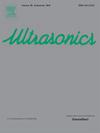聚焦超声场对动脉粥样硬化斑块内热传递和流动的研究
IF 3.8
2区 物理与天体物理
Q1 ACOUSTICS
引用次数: 0
摘要
聚焦超声已广泛应用于软组织病变的热疗。在此过程中,由于介质的非均匀性,必须考虑非傅立叶热传导理论和多孔介质理论。研究了温度滞后和多孔介质对聚焦超声(FU)斑块消融和药物治疗的影响。本研究将TWMBT与多孔介质传热方程相结合,以表征FU应用期间动脉粥样硬化斑块(AP)内部温度分布。用有限元法求解了耦合方程。本文主要研究了孔隙度、渗透率和衰减系数对AP内温度和流速的影响。研究结果考虑了动脉壁厚度对FU加热AP的影响。此外,本研究定性分析了Pennes、TWMBT和多孔介质热传导方程之间的差异。结果表明,生物组织的温度响应表现出滞后行为,这与物理时间尺度有内在联系。由于靶组织和周围组织物理特性的差异,AP内的流体流动会对组织温度的分布产生影响,固体组织间的流动方向由渗透系数和超声强度决定。渗透系数、频率和衰减系数对AP内流体流动有显著影响。散热和热收敛都是组织内流体流动的特征,焦点位置和物性参数会影响组织内流体的散热和集热性能。此外,温度峰值可能不会出现在焦点处。该模型可为不同类型的精确热消融AP提供分析模板,除FU消融外,还包括射频消融、微波治疗和激光消融,并可为辅助药物输送提供案例。本文章由计算机程序翻译,如有差异,请以英文原文为准。
Study of heat transfer and flow within atherosclerotic plaques in a focused ultrasound field
Focused ultrasound has been widely used for the thermotherapy of soft tissue lesions. In this process, non-Fourier heat conduction and porous medium theory has to be considered because of non-homogeneous media. The study estimates the effects of the temperature lag and porous medium on the plaque ablation and drug treatment by focused ultrasound (FU). This study integrated TWMBT with the porous media heat transfer equation to characterize the internal temperature distribution within atherosclerotic plaque (AP) during FU application. The coupling equations are solved with finite element method. This paper focuses on the effects of porosity, permeability, and attenuation coefficient on the temperature and flow rate within the AP. The results consider artery wall thickness on heating of AP by FU. In addition, this study qualitatively analyzed the differences among the Pennes, TWMBT, and porous media heat conduction equations. The results show that the temperature responses of biological tissues exhibits lagging behaviors, which are inherently related to the physical time scale. Because of the disparities in the physical characteristics of the target and surrounding tissues, fluid flow within AP can have an impact on the distribution of tissue temperature, the direction of flow between solid tissues is determined by the permeability coefficient and ultrasonic intensity. The permeability coefficient, frequency and attenuation coefficient have a significant effect on the fluid flow within AP. Both heat dissipation and heat convergence are characteristics of fluid flow within the tissue, the focal location and the physical property parameters may affect the fluid heat dissipation and heat collection properties within the tissue. Furthermore, the temperature peak may not occur at the focus. The model can provide an analytical template for different types of precise thermal ablation AP, including radiofrequency ablation, microwave therapy, and laser ablation besides FU ablation, and can also provide a case for adjunctive drug transport.
求助全文
通过发布文献求助,成功后即可免费获取论文全文。
去求助
来源期刊

Ultrasonics
医学-核医学
CiteScore
7.60
自引率
19.00%
发文量
186
审稿时长
3.9 months
期刊介绍:
Ultrasonics is the only internationally established journal which covers the entire field of ultrasound research and technology and all its many applications. Ultrasonics contains a variety of sections to keep readers fully informed and up-to-date on the whole spectrum of research and development throughout the world. Ultrasonics publishes papers of exceptional quality and of relevance to both academia and industry. Manuscripts in which ultrasonics is a central issue and not simply an incidental tool or minor issue, are welcomed.
As well as top quality original research papers and review articles by world renowned experts, Ultrasonics also regularly features short communications, a calendar of forthcoming events and special issues dedicated to topical subjects.
 求助内容:
求助内容: 应助结果提醒方式:
应助结果提醒方式:


